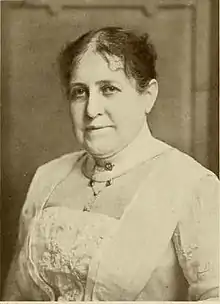Elise J. Blattner
Elise Jecko Blattner (1854–1926) was a traveler and lecturer who was reputed to be the first person west of the Allegheny Mountains to illustrate her talks with lantern slides.[1]

Personal
Elise Jecko was born on or about May 13, 1854, in St. Louis, Missouri.[2][3][4] to Joseph Jecko of Alsace and Clara Heimbach of Koblenz.[5]
She won a university scholarship through her record in high school but did not accept it.[1][2]
She had a daughter, Clara Blattner, born in St. Louis on October 15, 1877.[6] Clara graduated from Wellesley College.[2]
At the age of 25, Elise J. Blattner was married to John Forsting on April 15, 1879, in St. Louis.[7] She was later married to Henry Blattner,[5] who died about 1922.[1] They were still married in 1909.[8]
She was fluent in Japanese and German.[9]
In 1913, she was living at 2914A Arkansas Avenue, St. Louis.[10] In 1917, she and her daughter were living at the same address. She listed her occupation as "lecturer."[11] She died of uremia and chronic nephritis at Barnes Hospital on June 8, 1926,[5] after an eight-week illness. She was survived by her daughter.[1] Her body was cremated on June 10, 1926.[5]
Professional
Henry Blattner, her husband, was a skilled amateur photographer who assisted in making the lantern slides for her lectures. "She was the first person to use lantern illustrations for art lectures west of the Alleghenies."[2]
In 1889 she made her first trip to Europe, spending a year at the University of Berlin and returning with about two thousand photographs of art objects.[1] In Berlin, she studied with Professor Hermann Grimm and, she said, "succeeded in overcoming Professor Grimm's objection to the lantern and persuaded him to have a fine one installed" in the university.[2]
She spent many years after 1896 in travel, and in May 1906, she and her daughter, Clara, began a five years' residence in Japan.[1][8]
In 1912, she and Clara returned to the United States aboard the SS Nippon Maru, sailing from Yokohama.[12][13]
Clara was also a lecturer, demonstrating the No dance, flower arranging, the tea ceremony, bonsedi, or sand pictures and kōdō, an incense game.[14]
Mrs. Charles P. Johnson, her biographer, said of her lectures that "her manner of delivery is the most polished imaginable; her voice is pleasing, resonant, and clear."[2]
References
- "10 Jun 1926, Page 23 - St. Louis Post-Dispatch at Newspapers.com". Newspapers.com.
- Mrs. Charles F. Johnson, Notable Women of St. Louis, 1914
- Passport application, July 1, 1896
- Passport application, May 16, 1911
- "Death certificate" (PDF).
- Certificate of registration of American citizen, 1909
- www.ancestry.com https://search.ancestry.com/cgi-bin/sse.dll?indiv=1&dbid=1171&h=510192958&usePUB=true&_phsrc=AyH177&_phstart=successSource&requr=2555265023246336&ur=0&gsfn=&gsln=&h=510192958.
{{cite web}}: Missing or empty|title=(help) - 1909 consular record
- "9 Feb 1912, Page 4 - Natchez Democrat at Newspapers.com". Newspapers.com.
- 1913 City Directory
- 1917 City Directory
- 1912 passenger list
- Honolulu passenger and crew list
- "26 Dec 1913, Page 12 - Daily Arkansas Gazette at Newspapers.com". Newspapers.com.